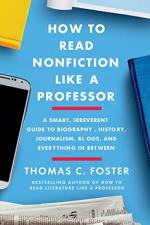
|
| Name: _________________________ | Period: ___________________ |
This quiz consists of 5 multiple choice and 5 short answer questions through Section 4: Chapter 13,"On the Stump" through Chapter 15, "Reading Internet Sources".
Multiple Choice Questions
1. In Chapter 15, "Reading Internet Sources," Foster cites Wikipedia as the source of his information about the development of the internet. What might we reasonably call his use of Wikipedia as a source?
(a) Ironic.
(b) Engaging.
(c) Scholarly.
(d) Careless.
2. In "Interrogating the Text," Foster says that readers should beware of ad hominem arguments. What he means is that readers should be suspicious when writers do what?
(a) Portray the opposition argument as much weaker than it actually is.
(b) Contend that because something is new it must be better or more correct.
(c) Attack the people making arguments instead of the arguments themselves.
(d) Appeal to emotion rather than to logic.
3. In Chapter 15, "Reading Internet Sources," what does Foster say the main role of editors is?
(a) Protecting the interests of the public.
(b) Protecting the interests of media owners.
(c) Critical thinking.
(d) Proofreading.
4. In Chapter 4, "The Parts You Don't Read," what part of a text does Foster say is "under-read"? (39).
(a) Introductions.
(b) Titles.
(c) The index.
(d) The table of contents.
5. In Chapter 12, "Life from the Inside," Foster says that an author of a history about long-ago events is not really so much a reporter as a what?
(a) Critic.
(b) Compiler.
(c) Artist.
(d) Poet.
Short Answer Questions
1. According to Foster in Chapter 9, "Living the News," what is McPhee's purpose in comparing geological change over time to a road trip?
2. In Chapter 8, "Bringing the News," Foster says that All the President's Men is sui generis. He is saying that this book is what?
3. In Chapter 11, "Life from the Inside," what does Foster call works that people write about their own experiences with illness and dying?
4. In Chapter 9, "Living the News," which work does Foster say is likely the first example of New Journalism?
5. In Chapter 9, "Living the News," what does Foster say is the main difference between New Journalism and immersive journalism?
|
This section contains 394 words (approx. 2 pages at 300 words per page) |

|




